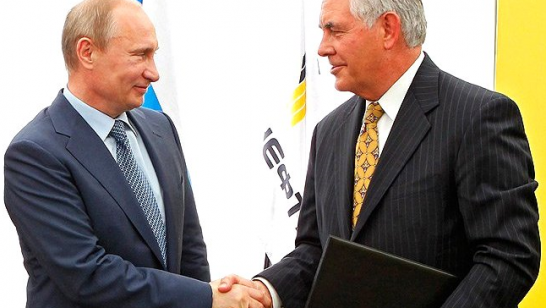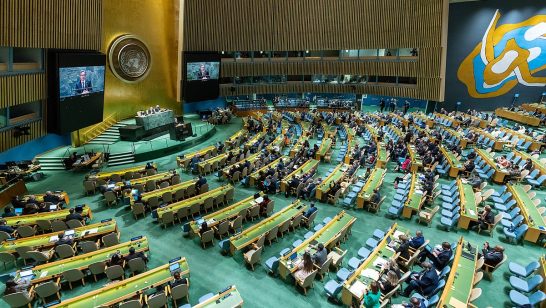
Trump’s election offers an opportunity to fix the Iran deal and improve our proliferation efforts. No, we are not crazy. Read on. The Iran agreement was a risky and so far successful venture. It stands well on its own feet. It is not a perfect agreement. There are some flaws including the relatively short time in which it is to be effective. But rather than destroying it and starting all over again, we have what we think is a better idea – building on it to use its key principles to create a global effort to deal with enrichment and plutonium separation now.
For too long now attempts to move ahead in successive five year reviews of the Nuclear Non-Proliferation Treaty (NPT) and at the Conference on Disarmament in Geneva have been deadlocked over abstruse procedural wrangles. It is time now to get the general non-proliferation process on the road again.
Two years ago, the agreement between the P5+1 and Iran averted a crisis which could have brought the entire non-proliferation regime into jeopardy and the region into conflict. But it is time now to draw on that agreement to use its standards by applying them to all countries seeking to enrich uranium for any purpose or attempting to use plutonium for reactor fuel.
Highly enriched uranium (HEU) at a level around and above 80% in U235 is a major proliferation risk. Anyone knowing how to enrich uranium, particularly through the use of modern centrifuges, can develop the capability to produce HEU. The Iran agreement controls that three ways – by limiting the amount of low enriched uranium (LEU) produced, capping the percentage of enrichment below 3.67 %, and specifying the number and type of centrifuges in use. Moving the enriched material into fabricated fuel elements and adding multinational investment in enrichment facilities can enhance the rigor and transparency of the deal. This will help to keep the amount enriched within the needs of the producing state for civil purposes with a reasonable amount for sale to others. Together with the new and enhanced International Atomic Energy Agency (IAEA) inspection arrangements, it will assure that verification will provide timely notice of attempts to misuse civil facilities for military purposes.
The Iran Agreement completes the work of the Non-Proliferation Treaty (NPT) for the first time by setting limits on enrichment and plutonium separation. Such limits will help by making it clear that enrichment for civil purposes is not in itself against the provisions of the NPT and by also blocking or making more prolonged any attempt to use civil facilities to “breakout”.
Uranium isn’t the only concern. Plutonium produced in reactors when uranium fuel is burned up, once separated from the spent fuel, is a weapons-ready material as well. Some advocate its use as a reactor fuel to supplement or replace uranium. The good news is that by any economic test, plutonium fuel, all costs considered, is not likely for some very prolonged period ever to compete on a cost basis with LEU. That test alone should guide and govern its use. And while carefully controlled research might continue, as with the Iran agreement, separation of plutonium should be frozen and await its being able to pass the competitive cost test at a minimum. Given the complexities and issues in dealing with plutonium, it might be wise to start with enrichment and later add plutonium.
Such an agreement could serve several useful purposes. First, it would take Mr Trump’s opposition to the agreement and by putting in place an effective follow-on enhance world-wide efforts to curb proliferation. Second, it could serve as a ‘bridge builder’ initiative between Russia and the US in light of the current parlous relations between them. Third, if fully accepted by the five internationally recognised nuclear weapon states (P-5), it will put into the form of an inspected agreement the five unilateral moratoria currently adopted by them with respect to enrichment of uranium and separation of plutonium for use in nuclear weapons. (The aim should be to include India, Israel, North Korea and Pakistan, but that step should not stand in the way of an otherwise widely beneficial arrangement for humanity). Fourth, it will set a global standard which would apply to all states aspiring to enrich uranium in the future (Argentina, Brazil, South Korea). Fifth, It will take Iran out of a special category and make it part of an international regime which should be widely applied to all states. Sixth, because it should be an accord which will last without fixed termination, Iran too will become part of a new deal without set time limitations.
This will not be easy. Universal adherence by all enriching states is the right goal. Israel, as far as we know, has not relied on enrichment, while the other three have a capacity for both sources of weapons fuel and might be persuaded to give up one – uranium enrichment – as a first step. P-5 unity around such an approach (and German full support) should set an example in keeping with Article VI of the NPT which asks the nuclear powers to do their share to rid the world of nuclear weapons. This should help with those who seek balanced arrangements by including at the beginning the NPT-recognised nuclear states
The opposition to the arrangement may well come from several quarters. Some states, including the US, use HEU for naval reactor fuel. But France has pursued the use successfully of LEU for naval propulsion. A set time period of a decade or more should help in making such a transition general. Plutonium breeder reactors are seen by some as an answer to energy needs now and in the future. Successful efforts in that direction have been elusive at best. Continued R and D might be permitted under effective IAEA monitoring. Some have argued that plutonium separation despite its high cost and technical difficulty is a better way to deal with spent fuel. But no one has come forward to indicate why it should be superior to the alternative of long term storage as spent fuel in safe sites under adequate inspection and control (Sweden and Finland). None of these impediments should be a deal breaker.
The Iran accord set the stage not just for dealing with Iran’s possible development of a nuclear weapon, but laid out for us some clear guidelines to building and strengthening our non-proliferation efforts for the future. Mr Trump’s election provides an opportunity to move to the next step and not only treat with Iran’s approach, but to make it widely and broadly applicable to new members of the civil nuclear club, the recognised nuclear states and gradually to the older holdouts. We should take heart from the achievement and continued observance of the Iran accord, but also use our good sense to generalise and globalise its advantages and thus make our planet safer and more secure.
The opinions articulated above represent the views of the author(s), and do not necessarily reflect the position of the European Leadership Network or any of its members. The ELN’s aim is to encourage debates that will help develop Europe’s capacity to address the pressing foreign, defence, and security challenges of our time.




